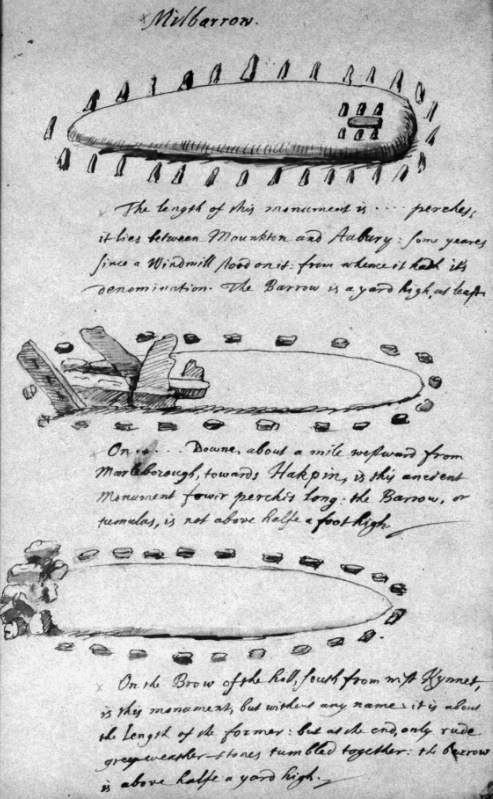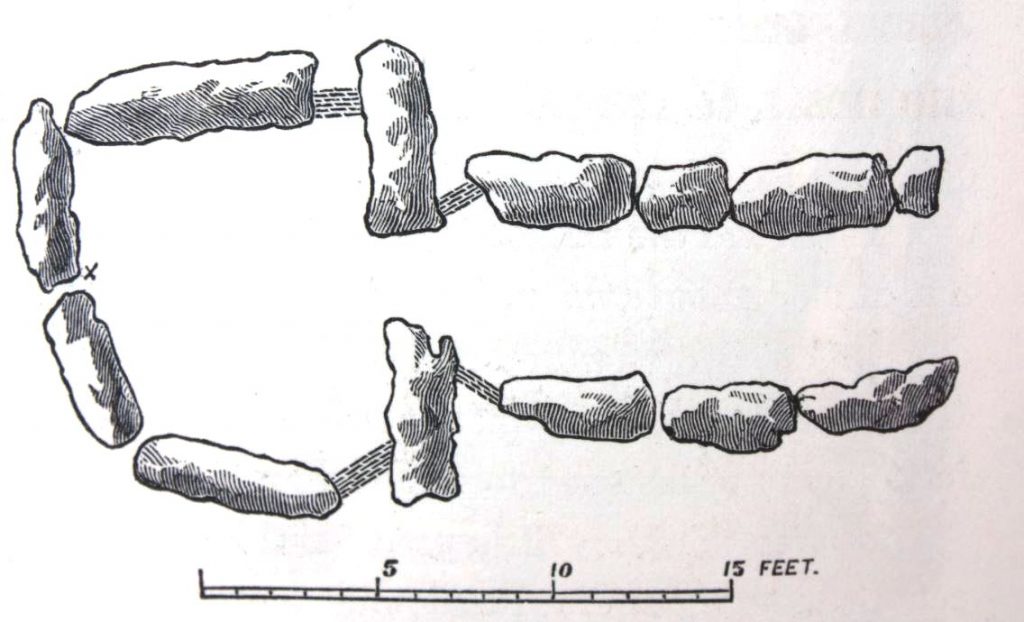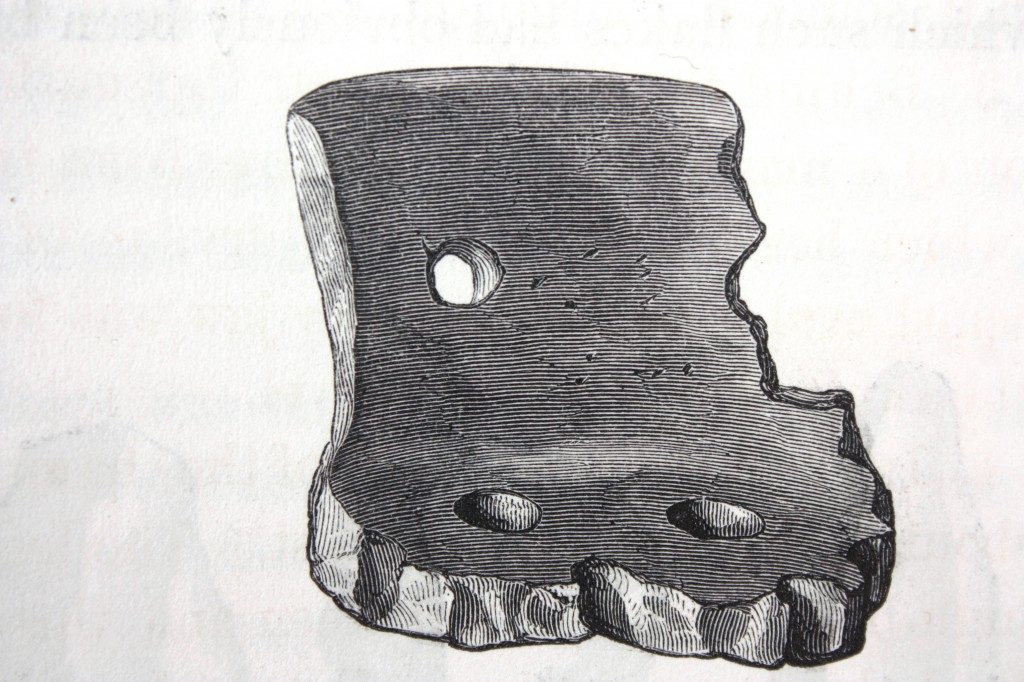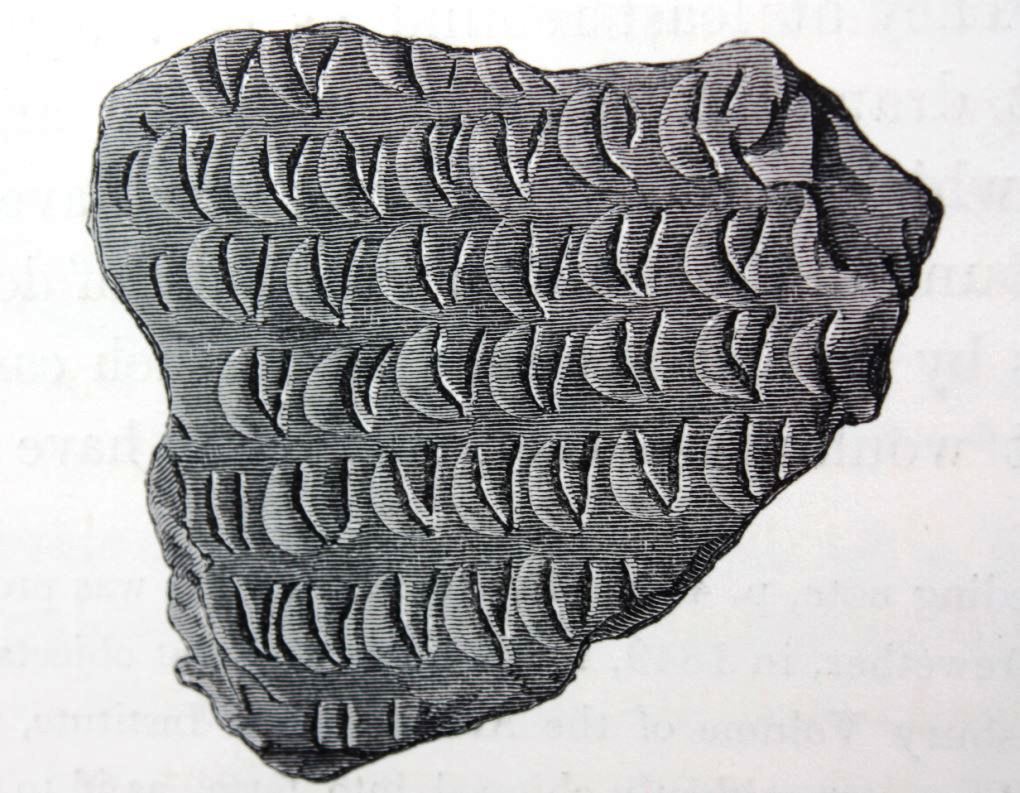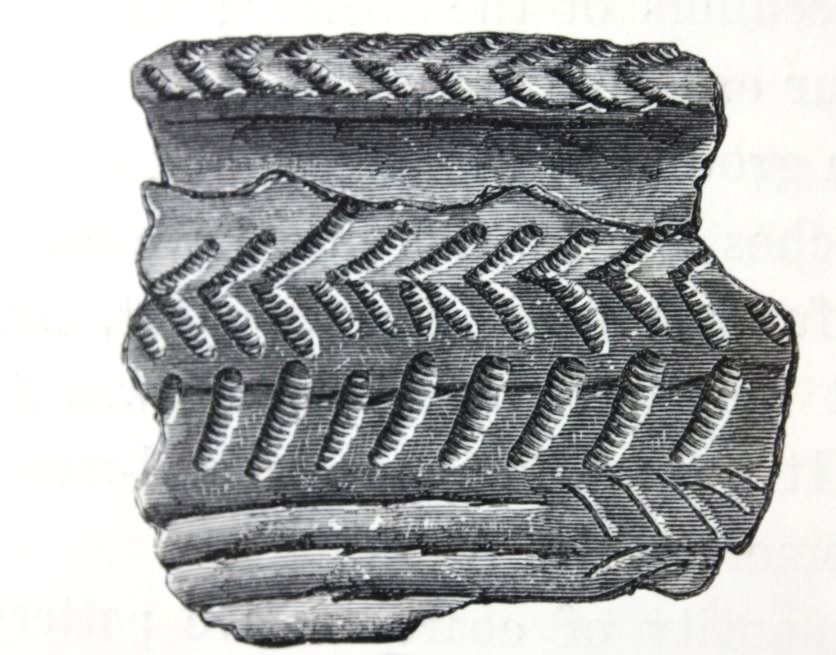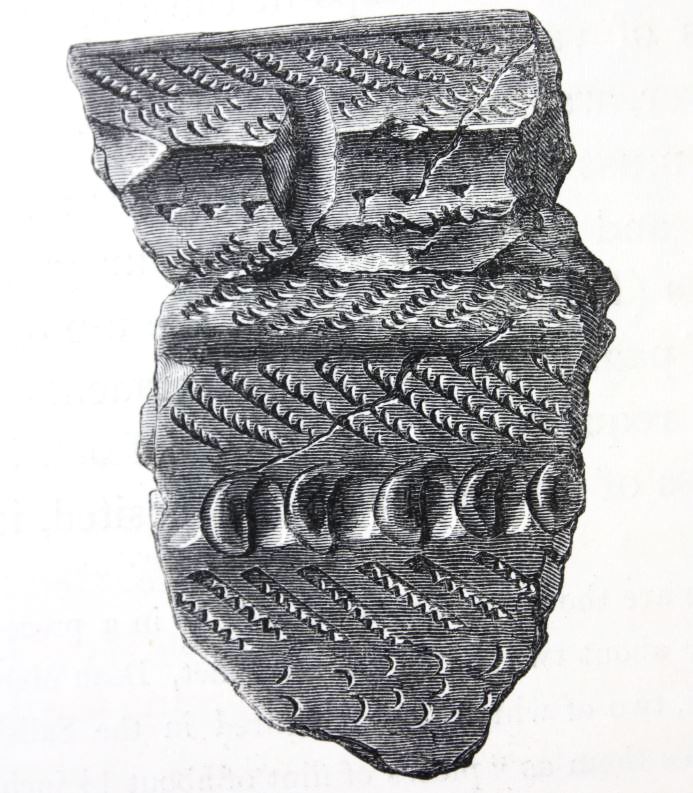West Kennet Long Barrow Wiltshire
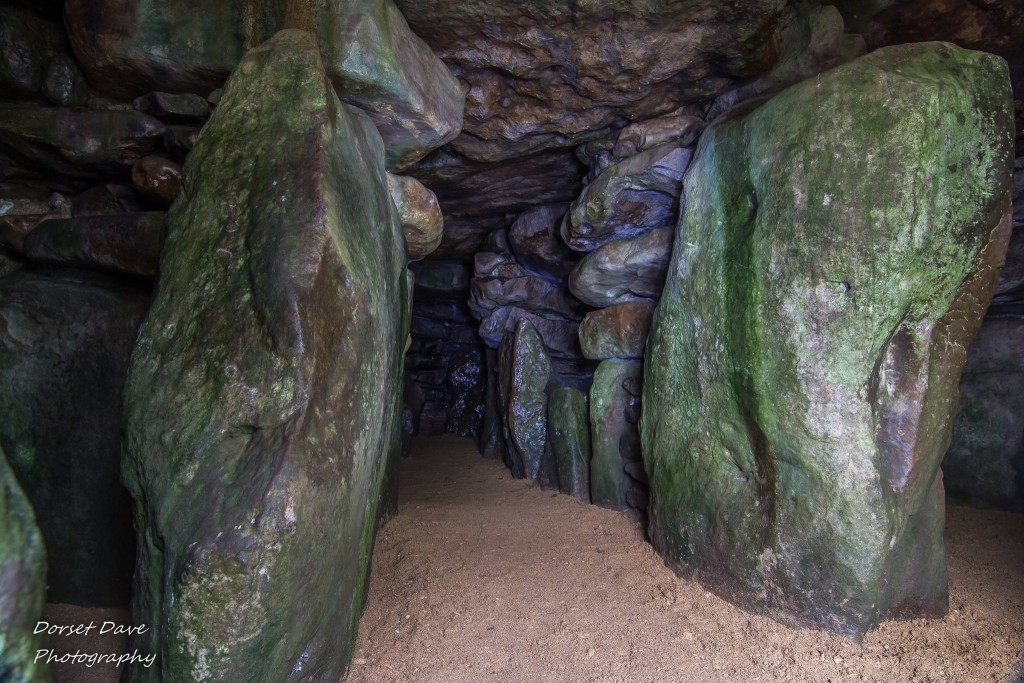
WRITTEN BY Austin Kinsley ON 19/06/18. West Kennet Long Barrow Wiltshire POSTED IN Avebury Landscape
‘The great old mound, with its grey time stained stones, among which bushes of the blackthorn maintain a stunted growth, commanding as it does a view of the great part of the sacred site of Avebury, has still a charm in its wild solitude, disturbed only by the tinkling of the sheep bell, or perhaps the cry of the hounds. Shade too, is not wanting; for on the north side of the barrow, occupying the place once filled by the encircling upright stones, are, what are rarely seen on these downs, several ash and elm trees, of fifty to seventy years growth. At the foot of the hill, half a mile away to the east, lies one of those long combs or valleys, where the thickly scattered masses of hard silicious grit, or sarsen stone, still simulate a flock of “grey wethers” which, as Aubrey says, “one might fancy to have been the scene where the giants fought with huge stones against the gods.” From this valley there can be little doubt were derived the natural slab-like blocks, of which our “giant’s chamber” and its appendages were formed.’ This quote is from a paper written by John Thurman after his excavations in the autumn of 1859 at West Kennet Long Barrow, Wiltshire, which was read out on 15 March 1860 at a meeting of the Society of Antiquaries of London.
John Thurnam (1810-1873) was a Wiltshire doctor and medical superintendent of the Wiltshire County Asylum. He used patients from the asylum to provide labour during his excavations, which were conducted to recover the human remains interred in the long barrow, rather than ‘treasure hunting’ for other artifacts which had often been the case previously when barrows were unearthed.
Below: John Thurnam’s illustration of West Kennet Long Barrow, Wiltshire, in its landscape, described in his 1860 paper as: ‘Plan showing the position of the Long Barrow at West Kennet, in relation to the circles at Avebury, Silbury Hill, etc’.
The earliest sketch of West Kennet Long Barrow was made by John Aubrey, the 17th century gentleman-scholar, who was described in Ruth Scurr’s excellent 2015 biography John Aubrey My Own Life as caring ‘far more for the preservation of history than for his own legacy’. The sketch, circa 1660, is reproduced below and shows that at that time the whole of the barrow was set round at its base with stones, which formed a complete peristalith.
Below: John Aubrey’s sketch of West Kennet Long Barrow, circa 1660.
Below: Two additional long barrows in the Avebury environs were also sketched by John Aubrey, similarly set round at their bases with stones.
Of later observations and sketches of the long barrow made by William Stukeley in the eighteenth century, John Thurnam’s 1860 paper adds: ‘Stukeley’s large view, taken from the south, shows no peribolus of stones on that side: but in two distant views six or eight standing stones appear at the east end. The rest of these stones figured by Aubrey sixty years previously, had probably been removed by that great depredator of the Avebury circles and avenues “Farmer Green”, who, about the year 1710 as we learn from Stukeley, removed similar stones from a neighbouring barrow “to make mere-stones withal” – the boundaries probably of his own sheep-walks’.
At the time of John Thurnam’s excavations, the long barrow was owned by Reverend R.M. Ashe of Langley Burrell near Chippenham in Wiltshire, and permission was not given to move any stones on the surface. Excavations located only the westernmost chamber of the five now known and in his own words the excavation of the chamber leading to the discovery of six human burials is as follows:
‘The floor of the chamber and gallery consisted of the gravelly clay, which here forms the natural subsoil; and the upright stones, which had been sunk a foot or two in the earth, were supported by small blocks of sarsen stone, closely rammed down in the floor. Both the gallery and chamber were filled with chalk rubble, covered at the top, to the depth of about a foot, with recent rubbish, which recent rubbish which had found its way under the cap-stones. In a clearing out of the gallery, a few scattered bones of animals, flakes and knives of flints, and fragments of British pottery, of various patterns were picked up. There were also part of a rude bone pin and a single bead of Kimmeridge shale, roughly made by hand’.
Below: A ground plan of the gallery and westernmost chamber excavated by John Thurnam in the Autumn of 1859, included in his subsequent report.
At the depth of five feet in the chamber, and extending slightly into the gallery, was a layer, three to nine inches in thickness, of a blackish, sooty and greasy-looking matter, mixed with the rubble, and most marked on the south side of the chamber. This blackish stratum, the nature and origin of which are by no means clear, was so defined that it could never have been disturbed since its original formation or deposit. At this level the flint flakes and implements and bones of animals were much more numerous than above. The bones were nearly all those of animals likely to have been used for food: the sheep or goat; ox, of a large size; roebuck (of which there was a part of a horn); and swine of various ages, including boars with tusks of large size. There were also some of the bones of a badger, an animal still sometimes eaten by the peasantry.
Below: The westernmost chamber.
Beneath the black stratum, the chalk rubble, of a dirty white colour, extended to a depth of two feet; in this were found four human skeletons, and parts of two others, all resting on the floor of the chamber. The exact position in which the bodies had been deposited was by no means evident; the bones, without being scattered, were further apart than usual, as if the chalk rubble had fallen down gradually on the decaying bodies and separated the bones.
No.1. In the southeast angle of the chamber, to the left of the entrance, was the skeleton of a youth of about seventeen years of age, apparently in a sitting posture. The skull was extensively fractured at the summit by what appeared to have been the death blow. The thigh bones measured about sixteen and a half inches. The crowns of the large teeth were slightly eroded. The wisdom teeth had not penetrated the gums. Behind this skeleton, and in the very angle of the chamber, was a pile of pottery fragments.
No.2. Almost in the centre of the floor was the skeleton of a man of about fifty years of age, of large and powerful frame, the humerous thirteen inches and the thigh bone twenty inches in length. The teeth were very much eroded, the bones thick and heavy. A fracture, probably the death wound, extended from one temple to the other through the forehead into the right cheek, entirely severing the malar bone, which had fallen off below the skull and was preserved by the clay in which it was embedded, of an ivory-like hardness, contrasting strongly with the light friable character of the bone from which it had been separated. The skull, somewhat large and flat, was of an elongated oval form.
No.3. Behind the last, and near the southeast corner of the chamber, was the skeleton of a man of medium stature, from thirty to thirty-five years of age. The skull, which bears no marks of injury, is of a beautifully regular and somewhat lengthened oval form. The lower jaw was found at the distance of a foot or more from the skull, and at a lower level.
No.4. In the northwest angle of the chamber was a skeleton of a man of middle size, about the same age as the last. The legs were flexed against the north wall. The thigh bone measured seventeen and three-quarter inches. The skull faced the west, and the lower jaw was found about a foot nearer to the centre of the chamber, as if it had fallen from the skull in the process of decay. Being embedded in the clay floor, the jaw was singularly well preserved, of an ivory whiteness and density, and even retained distinct traces of the natural oil or medulla. The form of the skull is a decidedly elongated and narrow oval, differing much from the usual in ancient British skulls from the circular barrows of Wilts and Dorset. All of its characteristics are more marked; but it bears a singular resemblance, especially in the face to skull No. 3; and, like that, presents no marks of violence. Lying over this skull was a small slab of sarsen stone, and beneath this, two fragments of a fine and peculiar black pottery, neatly marked with lattice lines, corresponding fragments of which were found in a distant part of the chamber.
Below: One of the two fragments of pottery with lattice lines:
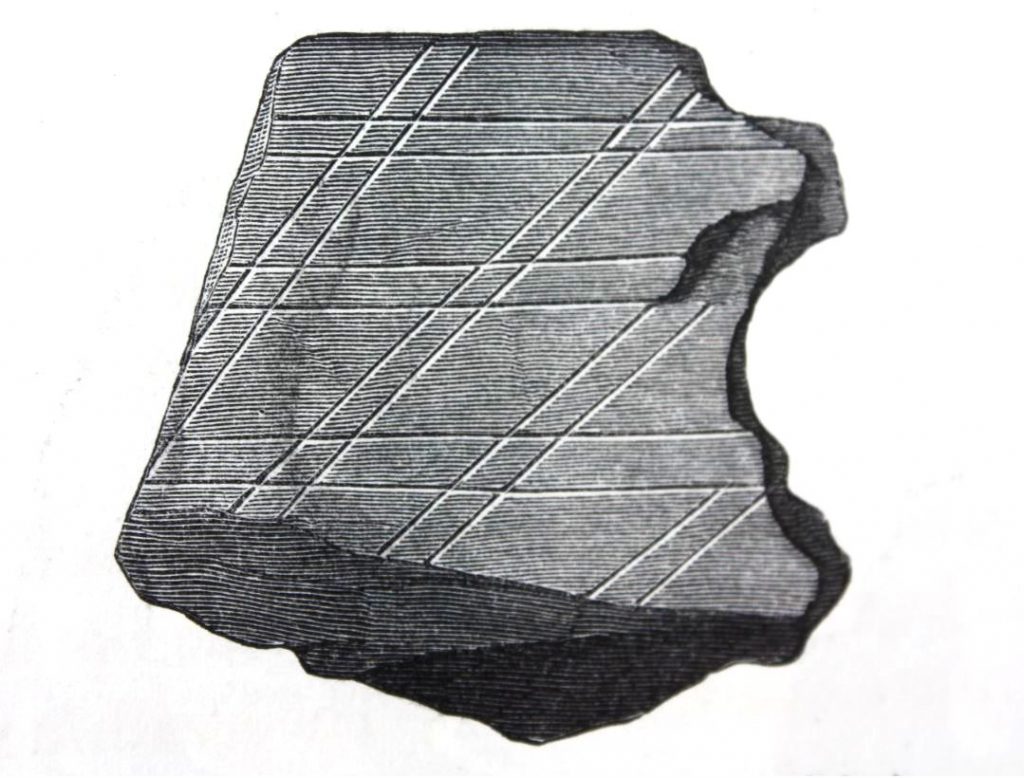 Near the skull was a curious implement of black flint, a sort of circular knife with a short projecting handle, the edges elaborately chipped. (Photographed below from the original 1860 woodcut illustration.)
Near the skull was a curious implement of black flint, a sort of circular knife with a short projecting handle, the edges elaborately chipped. (Photographed below from the original 1860 woodcut illustration.)
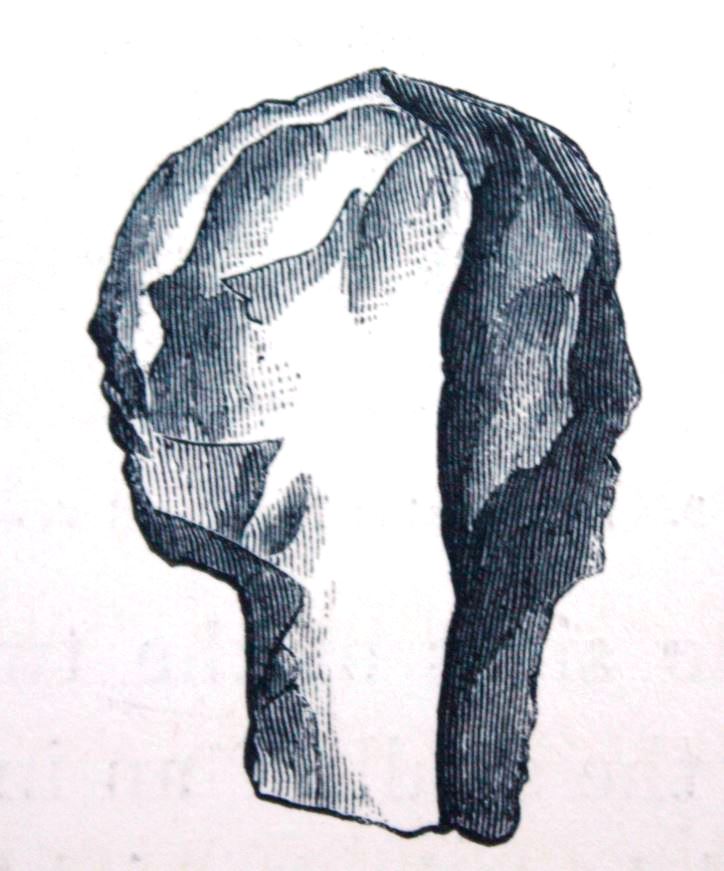 This skeleton was perhaps that of the chief for whose burial this chamber and tumulus were erected, and in honour of whom certain slaves and dependents were immolated.
This skeleton was perhaps that of the chief for whose burial this chamber and tumulus were erected, and in honour of whom certain slaves and dependents were immolated.
No.5. Between and behind the two last skeletons, close to the middle of the west wall of the chamber, were parts of the skeleton of a man of middle age, consisting of the occiput, temporal bones, lower jaw, cervical vertebrae, sternum and bones of the arm. Close to these was a portion of a curious saucer of coarse pottery, perforated with a series of holes at the bottom, so as to form a kind of strainer (see photograph below) and with a hole at each side by which it might have been suspended; another fragment of the same vessel was found at the opposite side of the chamber.
No.6. Very near the last, and between the sides of the two upright stones forming the west wall, was the chief part of the skull of an infant about a year old, with no other part of the skeleton, but which perhaps might have been found outside the chamber. With the skull bones were three sharp flint flakes and a large heap of fragments of pottery.
A third heap of pottery was found in the northeast angle of the chamber. A morsel of decayed wood was picked up near this part of the floor, which two skilled microscopic observers have ascertained to be oak, as Professor Queckett believes of the now less common species Quercus sessiliflora. In the southwest corner, between two adjacent uprights, was a curious ovoid sarsen stone (hard silicious grit) weighing 4 3/4 lbs; it was tinged of a red colour, from exposure to fire, was broken at one end and chipped and battered at the other. It had obviously been used as a mallet, perhaps for breaking the flints of which the numerous flakes and knives in the chamber were formed. A very large number of flint flakes with sharp cutting edges were obtained from the black stratum, and from near the floor of the chamber. Nearly three hundred were collected; but of these perhaps two thirds might be regarded as refuse, but clearly not as accidental. Some flint nodules such as abound in the chalk, appeared to have been broken and the resulting flakes used as knives, probably at a funeral feast on the spot. Three or four cores, from which such flakes had obviously been broken off, were found. The surfaces of the flakes are almost all stained of a milky white.
Below: Flint implements from the long barrow.
Below: fragments of pottery discovered during the Autumn 1859 excavations of West Kennet Long Barrow.
It is worthy of remark that not a bit of burnt bone or other sign of cremation was met with’.
Martin Smith and Megan Brickley, in People of the Long Barrows, write of John Thurman’s working methods as ‘Overall Thurnam’s examination and recording of the skeletal material is more thorough than was typical previously’ and that his ‘interpretation of the monument reveals the prevailing assumptions of the time’.
Facts about West Kennet Long Barrow:
- It is approximately 340 feet long.
- It is on an east-west equinox axis.
- The width of the long barrow tapers, being 70 feet at the eastern end and 40 feet at the western.
- It is on a ridge of chalk downland two miles south of Avebury stone circles and monument.
- At its maximum unmutilated height the mound of the barrow rose 14 feet above the old surface line.
- Besides the sarsen stones, there is oolite infilling which has variously been suggested as originating from at Cherhill, a few miles to the west or the Frome area in Somerset approximately 25 miles to the south west.
- Stuart Piggott wrote in 1958: ‘The plan of the burial chambers on complete excavation showed a symmetrical composition, with a wide passage some 23 feet long leading to a polygonal western or terminal chamber, and with two pairs of lateral chambers opening from it, three of these being approximately rectangular in plan, while one (the north west) is polygonal. The passage opens onto a shallow semi circular forecourt 30 feet across and about seven feet deep.
- The two pairs of lateral chambers vary in size from 2 metres to 4 metres and have a maximum internal height of 2.5 metres.
- A ditch once flanked the long barrow, the chalk rubble from which was used to construct the main body of the mound.
- In 2010 Professor Julian Richards wrote that the reconstruction work that followed the 1956 excavations resulted in a total reconstruction of the upper structure and passage above the height of the orthostats. The sarsen stones around the east entrance were also repositioned.
The long barrow was subsequently excavated by Professor Stuart Piggott and his staff and students of the Department of Prehistoric Archaeology of Edinburgh in 1955 and 1956. Professor Piggott wrote a summary of the results published in Antiquity magazine in 1958 from which the summary below has been extracted:
- On more than one of the chamber uprights, and on the southern of the three blocking stones, were polished area’s where stone or flint axe-blades had been ground or resharpened.
- Sherds of Windmill Hill type Neolithic pottery were found in the stone hole of one of the facade uprights, and in that of one of the passage uprights as well.
- The floors of chambers and passage consisted of the same old ground surface as observed under the mound, and burials had been laid directly on this.
- As usual in collective tomb burials there were in addition to identifiably complete or partially complete skeletons, quantities of disordered bones.
- The remains were mainly concentrated at the rear of the chambers; in the northeast chamber a complete crouched burial of an elderly man occupied the western corner, with a leaf shaped flint arrowhead in the region of his throat, and above him a mass of cremated bones representing two individuals, one male and one female.
- In the south west chamber a row of three skulls had been laid against the rear wall, and a cache of vertebrae and long bones was similarly placed in the northwest chamber.
- Professor Wells assessed the material from the four chambers excavated in 1955 as representing upwards of twenty adults, one youth and at least a dozen children. The latter were particularly abundant in the southeast chamber.
- Professor Wells was able to demonstrate that some very curious features in the circumstances of the West Kennet burials. In the first place, there are not enough skulls to go around, and more lower mandibles than skulls. This (as he says) suggests that skulls were removed after the remains were reduced to skeletal form, in some instances leaving the lower jaw behind, and still more odd is the fact that there is a similar shortage of the larger limb-bones, which may also have been removed from the tomb after burial.
- In the southeast chamber against the west wall were the crushed remains of what had been a complete bowl of Windmill Hill ware, with a slightly thickened rim decorated with oblique lines of ‘imitation cord’ pattern and other sherds of unornamented pottery of undifferentiated Windmill Hill type were found on the floor of the northeast chamber.
- Subsequent to the final deposition of burials the chambers and passage were deliberately filled with irregular layers of chalk rubble, mainly clean but with many seams and patches (up to a foot or so in thickness) of rubble stained brown and black with charcoal dust and containing abundant potsherds, animal bones, flint flakes and occasional implements, bone points and other tools and frequent beads made of bone, stone and perforated shell. A similar but less concentrated scatter occurred sporadically in the clean layers.
- The sherds varied in size from small scraps to large fragments representing half a pot or more, and represented various forms of Peterborough Ware, Rinyo-Clacton Ware (now referred to as grooved ware), and Bell Beakers. No Windmill Hill ware was present, nor was there any sequential stratification among the various types of pottery — sherds of Beaker, for instance — occurring in the lowest layers (immediately above the primary burials) in the northeast chamber, as well as at other levels.
- A striking find was the greater part of a fine Bell-Beaker carefully placed upside down in an angle of the northwest chamber at a high level. In sorting the pottery it has been found that no whole pot is represented, that fragments of the same vessel may be scattered between two or more chambers, and that many pots survive as only a group of sherds none of which join. In other words, the pots were not broken in the tomb as a part of funerary ritual, but were brought there as already scattered potsherds.
- Although burnt fragments of bone were relatively common, and other signs of burning and fire, no fire had been made within the tomb at any stage of filling.
- The filling had been carried up completely to the underside of the capstones.
In 2007 Professor Alex Bayliss, Professor Alasdair Whittle, et al published a paper on the dating of West Kennet Long Barrow from which the following brief summary has been extracted and the full report is available here:
- 36 individuals are represented in the primary mortuary deposits discovered during the two excavations described above.
- Thirty-one radiocarbon dates were taken on available bones from the individuals found in the long barrow.
- The primary mortuary deposits occurred between 3670-3635BC.
- The last interments of this initial use of the chambers probably occurred in 3640-3610BC.
- The difference between these two distributions suggests that this primary mortuary activity probably only continued for 10-30 years.
- After a hiatus probably lasting for rather more than a century, the infilling of the chambers began in 3620-3240BC and continued into the second half of the third millenium BC.
Thank you Dave Lawrence of Dorset Dave Photography for use of the lead photograph and Pete Glastonbury for the spring equinox timelapse sunrise video linked below.
Too old
For ghosts even
In narrow rooms like marrow bones
Sucked clean
– Ann F Schwader
Below: A timelapse video by Pete Glastonbury of the Spring Equinox sunrise from inside West Kennet Long Barrow in 2014.




